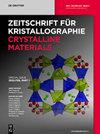Artefacts from Ban Chiang, Thailand: Pre-metal Age cord-marked pottery
IF 2.7
4区 材料科学
Q3 CRYSTALLOGRAPHY
Zeitschrift Fur Kristallographie-Crystalline Materials
Pub Date : 2023-07-03
DOI:10.1515/zkri-2023-0015
引用次数: 0
Abstract
Abstract Pottery excavated from the archeological UNESCO world heritage site Ban Chiang in Thailand stem from distinct periods. Black vessels with cord-mark design from Pre-metal Age (ca. 3000–1000 BC), Bronze Age pottery (ca 1000–300 BC) with yellow-brown surface and Iron Age samples (ca. 300 BC–200 AD) with red pictorial surface patterns. In a previous work [Bismayer U., Srilomsak S., Treekamol Y., Tanthanuch W., Suriyatham K. Artefacts from Ban Chiang, Thailand: pottery with hematite-red geometric patterns. Z. Kristallogr. 2020, 235, 559–568] we studied the mineralogical composition and their surface colour materials of shards from Bronze and Iron Age. In this work we focus on bulk features of the dark Pre-metal Age cord-marked ceramic shard PSN2-S10E13 and compare its elemental and mineralogical composition with bulk composition of sample 5412-S6E15 from Bronze Age. Experimental techniques are electron microprobe, X-ray powder diffraction, FTIR spectroscopy, optical microscopy and X-ray tomographic microscopy (XTM). Sample PSN2-S10E13 contains more quartz than 5412-S6E15. In the bulk of the Pre-metal Age shard, diffraction signals of mullite occur, indicating higher firing temperatures compared to the younger sample. Phyllosilicate signals are seen in FTIR spectra of both shards. E-modes of quartz dominate FTIR spectra of both samples. Optical thin sections show voids around micro-particles in PSN2-S10E13 and XTM indicates that the pore volume percentage of sample PSN2-S10E13 is higher than in 5412-S6E15. Because of the large age gap to younger samples from Ban Chiang, the proper age of our oldest sample PSN2-S10E13 was determined using an accelerator mass spectrometer (AMS) by simultaneous 14C/12C and 13C/12C isotope ratio measurements which yielded a radiocarbon age of 3609 ± 29 BP (resp. 1659 ± 29 BC).泰国Ban Chiang的艺术品:前金属时代的绳纹陶器
摘要联合国教科文组织世界遗产泰国Ban Chiang考古发掘的陶器来自不同的时期。前金属时代(约公元前3000–1000年)的带绳纹设计的黑色器皿、表面为黄棕色的青铜时代陶器(约公元后1000–300年)和表面有红色图案的铁器时代样品(约公元前后300–200年)。在之前的一项工作[Bismayer U.,Srilomsak S.,Treekamol Y.,Tanthanuch W.,Suriyatham K.泰国Ban Chiang的艺术品:赤铁矿红色几何图案的陶器。Z.Kristalllor.20202235559-568]中,我们研究了青铜和铁器时代碎片的矿物学组成及其表面颜色材料。在这项工作中,我们重点研究了深色金属时代前帘线标记陶瓷碎片PSN2-S10E13的本体特征,并将其元素和矿物学组成与青铜时代样品5412-S6E15的本体组成进行了比较。实验技术有电子探针、X射线粉末衍射、红外光谱、光学显微镜和X射线断层显微镜。样品PSN2-S10E13含有比5412-S6E15更多的石英。在前金属时代碎片的主体中,出现了莫来石的衍射信号,表明与年轻样品相比,烧制温度更高。在两个碎片的FTIR光谱中都可以看到叶硅酸盐信号。石英的E模式主导了两个样品的FTIR光谱。光学薄片显示了PSN2-S10E13中微粒周围的空隙,XTM表明样品PSN2-S10 E13的孔体积百分比高于5412-S6E15。由于Ban Chiang年轻样品的年龄差距较大,我们使用加速器质谱仪(AMS)通过同时测量14C/12C和13C/12C同位素比率来确定最老样品PSN2-S10E13的适当年龄,其放射性碳年龄为3609±29 BP(分别为1659±29 BC)。
本文章由计算机程序翻译,如有差异,请以英文原文为准。
求助全文
约1分钟内获得全文
求助全文
来源期刊

Zeitschrift Fur Kristallographie-Crystalline Materials
CRYSTALLOGRAPHY-
CiteScore
2.00
自引率
16.70%
发文量
55
期刊介绍:
Zeitschrift für Kristallographie – Crystalline Materials was founded in 1877 by Paul von Groth and is today one of the world’s oldest scientific journals. It offers a place for researchers to present results of their theoretical experimental crystallographic studies. The journal presents significant results on structures and on properties of organic/inorganic substances with crystalline character, periodically ordered, modulated or quasicrystalline on static and dynamic phenomena applying the various methods of diffraction, spectroscopy and microscopy.
 求助内容:
求助内容: 应助结果提醒方式:
应助结果提醒方式:


